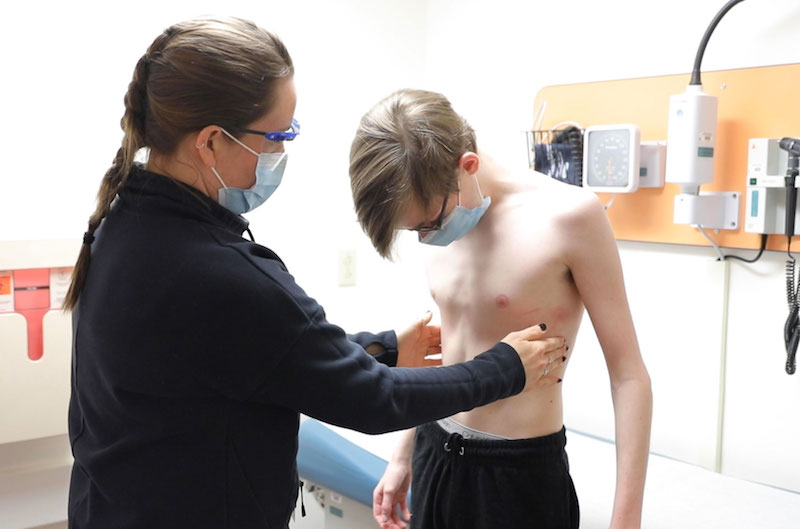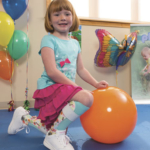Vacuum Bell therapy: A nonsurgical option for chest wall depression (pectus excavatum)

| While children with severe pectus excavatum often need surgery, vacuum bell therapy may make surgery unnecessary. Boston Children’s Hospital |
by Joanne Barker, Clinical Care, Boston Children’s Hospital June 29, 2021
Pectus excavatum is one of the most common chest wall abnormalities, affecting about 1 in 300 children.
Physicians at Boston Children’s Hospital helped define early treatments for chest wall problems and continue to develop innovative approaches to pectus excavatum. These innovations include a nonsurgical procedure called vacuum bell therapy. While children with severe pectus excavatum often need surgery, vacuum bell therapy may make surgery unnecessary.
Here, Kelly Bartkus, a nurse practitioner in the Pectus and Chest Wall Treatment Program who has cared for many patients with pectus excavatum, answers questions about the vacuum bell procedure and offers advice to help kids.
Pectus excavatum is a chest wall abnormality that causes a depression in the middle of the chest. This can develop at birth or develop when your child is older. This condition is often apparent during adolescence and can become more severe during growth spurts.

Types of Klobe Vacuum Bell: the pectus clinic works with Eckart Klobe, the inventor and manufacturer of the Klobe Vacuum bell, the first device developed specifically to offer a non-surgical treatment for pectus excavatum. Photo provided by Eckart Klobe
How does vacuum bell therapy work?
The vacuum bell is a cup-shaped device made of soft rubber that’s connected to a hand pump. The device is placed on the child’s chest and the pump is used to create suction. This suction slowly pulls the breastbone forward. After a period of consistent use, the breastbone and ribs stay forward on their own. Many patients notice improvement in their chest wall depression in the first three to four months.
How much time do patients have to spend wearing the device a day?
The goal is to wear the device for two hours, twice a day, but patients work their way up to this. At first, patients typically wear the device for about 30 minutes twice a day, then add 15 minutes each week. It should take about six weeks to reach a wear time of two hours twice a day.
Is vacuum bell therapy painful?
Vacuum bell therapy is not painful. Patients say they feel pressure when the device is first applied. But the treatment should not cause pain or feel uncomfortable. We tell families to contact us right away if it does.
Can kids go to school wearing the vacuum bell?
The device can be worn during regular activities throughout the day, however, we recommend wearing the device before or after school so that kids don’t have to put it on or take it off during school hours.
What activities should a child avoid while wearing the vacuum bell?
We recommend not wearing the device during gym class or contact sports. Likewise, the vacuum bell should not be worn while swimming or playing in the water. If a patient wants to apply the vacuum bell directly after these activities, it’s important to make sure their skin is completely dry.
What if my child feels self-conscious wearing the device?
If your child is self-conscious about how they look wearing the device, we recommend they only wear it at home. The vacuum bell is worn on a bare chest but kids usually wear a t-shirt or sweatshirt over it to cover the device. Depending on the clothing and material, the device may not be noticeable to others.
How long does vacuum bell treatment last?
Most kids use the device for at least one year. The length of treatment varies depending on the patient’s age, how old they were when they started vacuum bell treatment, and how severely their chest sinks inward.
Should parents or patients be concerned about side effects from the vacuum bell?
Some patients who undergo vacuum bell therapy report mild side effects, such as bruising, sore chest and back muscles, redness or skin irritation, and flabby skin. These side effects are usually temporary. If they do occur, we recommend wearing the device for shorter periods of time or reducing the pressure of the device (controlled by the number of “pumps”) until they subside.
What can families do to increase their chance of success with vacuum bell therapy?
Vacuum bell therapy is more effective when it begins when a child is about 11 years old. Children who start out with a mild chest wall depression and who use the device consistently have the greatest chance that the therapy will be successful.
 Source Boston Children’s Hospital
Source Boston Children’s Hospital
| Learn more about the Pectus and Chest Wall Treatment Program at Boston Children’s Hospital |
| Further reading |
Is vacuum bell therapy effective in the correction of pectus excavatum? Patel AJ, Hunt I. Interact Cardiovasc Thorac Surg. 2019 Mar 28:ivz082. doi: 10.1093/icvts/ivz082. Epub ahead of print. Full text, PDF
Surgical versus Vacuum Bell Therapy for the Correction of Pectus Excavatum: A Comparison of 1-Year Treatment Outcomes, Jung Y, Yi E, Lee K, Chung JH, Cho S, Lee S. J Chest Surg. 2021 Dec 5;54(6):473-479. doi: 10.5090/jcs.21.073. Full text, PDF
Vacuum Bell: Is It a Useful Innovative Device for Pectus Excavatum Correction? Loufopoulos I, Karagiannidis IG, Lampridis S, Mitsos S, Panagiotopoulos N. Turk Thorac J. 2021 May;22(3):251-256. doi: 10.5152/TurkThoracJ.2021.20035. Full text, PDF
Localized pectus excavatum treated with brace and exercise: Long term results of a Brazilian technique, Haje DP, Haje SA, Volpon JB, Silva ACOD, Lima LFB, Huang W. Acta Ortop Bras. 2021 May-Jun;29(3):143-148. doi: 10.1590/1413-785220212903241550. Full text, PDF
A novel three-dimensional printed vacuum bell for pectus excavatum treatment: a preliminary study, Deng X, Huang P, Luo J, Wang J, Yi L, Yang G, He S, Li X, Xiang S. J Cardiothorac Surg. 2020 Sep 10;15(1):240. doi: 10.1186/s13019-020-01276-y. Full text, PDF
Vacuum bell treatment of pectus excavatum: An early North American experience, St-Louis E, Miao J, Emil S, Baird R, Bettolli M, Montpetit K, Goyette J, Laberge JM. J Pediatr Surg. 2019 Jan;54(1):194-199. doi: 10.1016/j.jpedsurg.2018.10.011. Epub 2018 Oct 5. Full text
Nonoperative management of pectus excavatum with vacuum bell therapy: A single center study, Obermeyer RJ, Cohen NS, Kelly RE Jr, Ann Kuhn M, Frantz FW, McGuire MM, Paulson JF. J Pediatr Surg. 2018 Jun;53(6):1221-1225. doi: 10.1016/j.jpedsurg.2018.02.088. Epub 2018 Mar 8.
The Vacuum Bell device as a sternal lifter: An immediate effect even with a short time use, Togoro SY, Tedde ML, Eisinger RS, Okumura EM, de Campos JRM, Pêgo-Fernandes PM. J Pediatr Surg. 2018 Mar;53(3):406-410. doi: 10.1016/j.jpedsurg.2017.04.016. Epub 2017 May 1.
Vacuum bell therapy, Haecker FM, Sesia S. Ann Cardiothorac Surg. 2016 Sep;5(5):440-449. doi: 10.21037/acs.2016.06.06. Full text, PDF
Minimally invasive repair of pectus excavatum, Hebra A, Calder BW, Lesher A. J Vis Surg. 2016 Apr 5;2:73. doi: 10.21037/jovs.2016.03.21. Full text, PDF
Non-surgical treatment of pectus excavatum, Haecker FM, Sesia S. J Vis Surg. 2016 Mar 23;2:63. doi: 10.21037/jovs.2016.03.14. Full text, PDF
The vacuum bell for conservative treatment of pectus excavatum: the Basle experience, Haecker FM. Pediatr Surg Int. 2011 Jun;27(6):623-7. doi: 10.1007/s00383-010-2843-7. PDF
Also see
Vacuum Bell Therapy Pectus Clinic – St. George’s Hospital, London UK and Spire St. Anthony’s Hospital locations
Vacuum Bell Treatment for Pectus Excavatum Cincinnati Children’s
How to use a vacuum bell Life with Pectus






